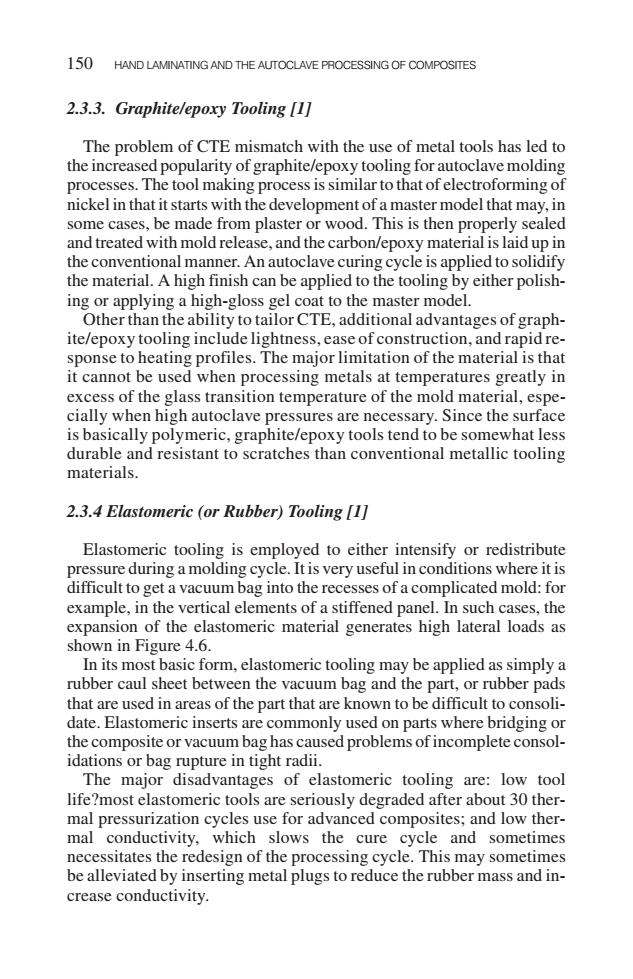正在加载图片...

150 HAND LAMINATING AND THE AUTOCLAVE PROCESSING OF COMPOSITES 2.3.3.Graphite/epoxy Tooling [1] The problem of CTE mismatch with the use of metal tools has led to the increased popularity of graphite/epoxy tooling for autoclave molding processes.The tool making process is similar to that of electroforming of nickel in that it starts with the development of a master model that may,in some cases,be made from plaster or wood.This is then properly sealed and treated with mold release,and the carbon/epoxy material is laid up in the conventional manner.An autoclave curing cycle is applied to solidify the material.A high finish can be applied to the tooling by either polish- ing or applying a high-gloss gel coat to the master model. Other than the ability to tailor CTE,additional advantages of graph- ite/epoxy tooling include lightness,ease of construction,and rapid re- sponse to heating profiles.The major limitation of the material is that it cannot be used when processing metals at temperatures greatly in excess of the glass transition temperature of the mold material,espe- cially when high autoclave pressures are necessary.Since the surface is basically polymeric,graphite/epoxy tools tend to be somewhat less durable and resistant to scratches than conventional metallic tooling materials. 2.3.4 Elastomeric (or Rubber)Tooling [1] Elastomeric tooling is employed to either intensify or redistribute pressure during a molding cycle.It is very useful in conditions where it is difficult to get a vacuum bag into the recesses of a complicated mold:for example,in the vertical elements of a stiffened panel.In such cases,the expansion of the elastomeric material generates high lateral loads as shown in Figure 4.6. In its most basic form,elastomeric tooling may be applied as simply a rubber caul sheet between the vacuum bag and the part,or rubber pads that are used in areas of the part that are known to be difficult to consoli- date.Elastomeric inserts are commonly used on parts where bridging or the composite or vacuum bag has caused problems of incomplete consol- idations or bag rupture in tight radii. The major disadvantages of elastomeric tooling are:low tool life?most elastomeric tools are seriously degraded after about 30 ther- mal pressurization cycles use for advanced composites;and low ther- mal conductivity,which slows the cure cycle and sometimes necessitates the redesign of the processing cycle.This may sometimes be alleviated by inserting metal plugs to reduce the rubber mass and in- crease conductivity.2.3.3. Graphite/epoxy Tooling [1] The problem of CTE mismatch with the use of metal tools has led to the increased popularity of graphite/epoxy tooling for autoclave molding processes. The tool making process is similar to that of electroforming of nickel in that it starts with the development of a master model that may, in some cases, be made from plaster or wood. This is then properly sealed and treated with mold release, and the carbon/epoxy material is laid up in the conventional manner. An autoclave curing cycle is applied to solidify the material. A high finish can be applied to the tooling by either polishing or applying a high-gloss gel coat to the master model. Other than the ability to tailor CTE, additional advantages of graphite/epoxy tooling include lightness, ease of construction, and rapid response to heating profiles. The major limitation of the material is that it cannot be used when processing metals at temperatures greatly in excess of the glass transition temperature of the mold material, especially when high autoclave pressures are necessary. Since the surface is basically polymeric, graphite/epoxy tools tend to be somewhat less durable and resistant to scratches than conventional metallic tooling materials. 2.3.4 Elastomeric (or Rubber) Tooling [1] Elastomeric tooling is employed to either intensify or redistribute pressure during a molding cycle. It is very useful in conditions where it is difficult to get a vacuum bag into the recesses of a complicated mold: for example, in the vertical elements of a stiffened panel. In such cases, the expansion of the elastomeric material generates high lateral loads as shown in Figure 4.6. In its most basic form, elastomeric tooling may be applied as simply a rubber caul sheet between the vacuum bag and the part, or rubber pads that are used in areas of the part that are known to be difficult to consolidate. Elastomeric inserts are commonly used on parts where bridging or the composite or vacuum bag has caused problems of incomplete consolidations or bag rupture in tight radii. The major disadvantages of elastomeric tooling are: low tool life?most elastomeric tools are seriously degraded after about 30 thermal pressurization cycles use for advanced composites; and low thermal conductivity, which slows the cure cycle and sometimes necessitates the redesign of the processing cycle. This may sometimes be alleviated by inserting metal plugs to reduce the rubber mass and increase conductivity. 150 HAND LAMINATING AND THE AUTOCLAVE PROCESSING OF COMPOSITES